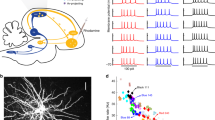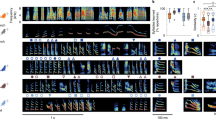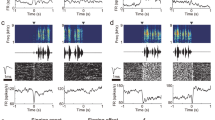Abstract
The cortical nucleus LMAN (lateral magnocellular nucleus of the anterior nidopallium) provides the output of a basal ganglia pathway that is necessary for vocal learning in juvenile songbirds. The shell subregion of LMAN (LMANshell) gives rise to recurrent loops that may subserve specific learning-related functions. We found that lesions in the LMANshell pathway caused no immediate disruption of vocal behavior, but prevented the development of stable vocal sequences and the ability to imitate vocal sounds.
This is a preview of subscription content, access via your institution
Access options
Subscribe to this journal
Receive 12 print issues and online access
$209.00 per year
only $17.42 per issue
Buy this article
- Purchase on Springer Link
- Instant access to full article PDF
Prices may be subject to local taxes which are calculated during checkout



Similar content being viewed by others
References
Doupe, A.J. & Kuhl, P.K. Annu. Rev. Neurosci. 22, 567–631 (1999).
Bottjer, S.W. Ann. NY Acad. Sci. 1016, 395–415 (2004).
Bottjer, S.W., Miesner, E.A. & Arnold, A.P. Science 224, 901–903 (1984).
Tchernichovski, O., Nottebohm, F., Ho, C.E., Pesaran, B. & Mitra, P.P. Anim. Behav. 59, 1167–1176 (2000).
Doyon, J. et al. Behav. Brain Res. 199, 61–75 (2009).
Seger, C.A. Neuroscientist 12, 285–290 (2006).
Hikosaka, O. et al. Trends Neurosci. 22, 464–471 (1999).
Alexander, G.E. & Crutcher, M.D. Trends Neurosci. 13, 266–271 (1990).
Person, A.L., Gale, S.D., Farries, M.A. & Perkel, D.J. J. Comp. Neurol. 508, 840–866 (2008).
Graybiel, A.M. Annu. Rev. Neurosci. 31, 359–387 (2008).
Aronov, D., Andalman, A.S. & Fee, M.S. Science 320, 630–634 (2008).
Long, M.A. & Fee, M.S. Nature 456, 189–194 (2008).
Foster, E.F. & Bottjer, S.W. J. Neurobiol. 46, 142–165 (2001).
Braun, K., Bock, J., Metzger, M., Jiang, S. & Schnabel, R. Behav. Brain Res. 98, 211–218 (1999).
Morrison, R.G. & Nottebohm, F. J. Neurobiol. 24, 1045–1064 (1993).
Acknowledgements
We are grateful to V. Miller-Sims and F. Johnson for assistance with data analysis. This work was supported by US National Institutes of Health grant NS037547.
Author information
Authors and Affiliations
Contributions
B.A. conducted the experiments. S.W.B. and B.A. designed the experiments. S.W.B. analyzed the data and wrote the manuscript.
Corresponding author
Supplementary information
Supplementary Text and Figures
Supplementary Figures 1–7, Supplementary Tables 1 and 2 and Supplementary Methods (PDF 1270 kb)
Supplementary Audio 1
Examples of vocal behavior for birds shown in Supplementary Fig. 2 (.wav files). These audio files are sample recordings of a lesioned bird (Lb772; 92% lesioned) and Lg676 (0% lesioned); corresponding sonograms are shown in Supplementary Fig. 2. (WAV 557 kb)
Supplementary Audio 2
Examples of vocal behavior for birds shown in Supplementary Fig. 2 (.wav files). These audio files are sample recordings of a lesioned bird (Lb772; 92% lesioned) and Lg676 (0% lesioned); corresponding sonograms are shown in Supplementary Fig. 2. (WAV 695 kb)
Rights and permissions
About this article
Cite this article
Bottjer, S., Altenau, B. Parallel pathways for vocal learning in basal ganglia of songbirds. Nat Neurosci 13, 153–155 (2010). https://doi.org/10.1038/nn.2472
Received:
Accepted:
Published:
Issue Date:
DOI: https://doi.org/10.1038/nn.2472
This article is cited by
-
Molecular specializations of deep cortical layer analogs in songbirds
Scientific Reports (2020)
-
Urotensin-related gene transcripts mark developmental emergence of the male forebrain vocal control system in songbirds
Scientific Reports (2019)
-
The expression of DARPP-32 in adult male zebra finches (Taenopygia guttata)
Brain Structure and Function (2019)



